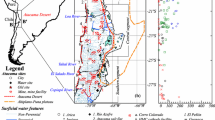Abstract
Charophyte oosporangia and water samples from a highly calcareous lake were measured for stable carbon and oxygen isotopic composition. The time period over which the oosporangia calcify is short, thus any biochemical relationship between the water and oosporangia"s calcite represents only one ‘time window’ (late Summer in Malham Tam). This important temporal restraint must also apply to interpretations of all fossil material measured. The δ18Oc of the charophyte oosporangia is deduced to be in equilibrium with the δ18Oω of the water for a given temperature. The δ13 Cc of the charophyte oosporangia was approximately 2.5 per mil lower than the δ13CDIC in the water we measured. With the release Of CO2 with phosphoric acid from the charophyte oosporangia, there was no significant difference in the δ18Oc values obtained, regardless of whether or not the carbonate was separated from the organic center, however δ13Cc values were marginally lower for carbonate plus organic center measurements. Our results indicate that fossil charophyte gyrogonites can be used to elucidate the geochemistry of the ancient water body in which they lived.
Similar content being viewed by others
References
Andrews JE, Riding R & Dennis PF (1993) Stable isotope compositions of Recent freshwater cyanobacterial carbonates from the British Isles: local and regional environmental controls. Sedimentology 40: 303–314
Berger J-P (1990) Floral changes in the molasse of western Switzerland (Oligo-miocene) palaeoclimatic implications. In: Knobloch E & Kvacek Z (Eds) Proceedings of the Symposium “Paleofloristic and Paleoclimatic Changes in the Cretaceous and Tertiary” 1989. Geological Survey, Prague
Collinson ME, Singer RL & Hooker JJ (1993) Vegetational change in the latest Eocene of southern England. In: Planderova E, Konzalova M, Kvacek Z, Sitar V, Snopkova P & Subballyova D (Eds) Proceedings of the Symposium “Paleofloristic and Paleoclimatic Changes During Cretaceous and Tertiary” 1992. Geologicky ustav dionyza stura, Bratislava
Covich A & Stuiver M (1974) Changes in oxygen 18 as a measure of long-term fluctuations in tropical lake levels and molluscan populations. Limnol. Oceanogr. 19: 682–690
Craig H (1965) The measurement of oxygen isotope palaeotemperatures. In: Tongiorgi E (Ed) Stable Isotopes in Oceanographic Studies and Palaeotemperatures 3 (pp 1–16)
Daley B & Edwards N (1990) The Bembridge Limestone (late Eocene) Isle of Wight, southern England: a stratigraphic revision. Tert. Res. 12: 51–64
Epstein S & Mayeda T (1953) Variation of O18 content of waters from natural sources. Geochim. Cosmochim. Acta 4: 213–224
Epstein S, Buchsbaum R, Lowenstam HA & Urey HC (1953) Revised Carbonate- water Isotopic Temperature Scale. Geol. Soc. Am. Bull. 64: 1315–1326
Feist-Castel M (1977) Evolution of the charophyte floras in the Upper Eocene and Lower Oligocene of the Isle of Wight. Palaeontology 20: 143–157
Ferguson D (1993) Plant taphonomic studies with special reference to Messel. Kaupia 2: 117–126
Fritz P (1975) Late-Quaternary climatic trends and history of Lake Erie from stable isotope studies. Science 190: 267–269
Fritz P & Poplawski S (1974) 18O and 13C in the shells of freshwater molluscs and their environments. Earth Plan. Sci. Lett. 24: 91–98
Grossman EL & Ku T-L (1986) Carbon and oxygen isotopic fractionation in biogenic aragonite: temperature effects. Chem. Geol. (Isotope Geoscience Section) 59: 59–74
Holmes PF (1965) The Natural History of Malham Tam. Fld. Stud. 2: 199–223
Hooker JJ, Collinson ME, Van Bergen PF, Singer RL, De Leeuw JW & Jones TP (1995) Reconstruction of land and freshwater palaeoenvironments near the Eocene-Oligocene boundary, southern England. J. Geol. Soc. Lond. 152: 449–468
Keith ML, Anderson GM & Eichler R (1964) Carbon and oxygen isotopic composition of mollusk shells from marine and fresh-water environments. Geochim. Cosmochim. Acta 28: 1757–1786
Leitch A (1991) Calcification of the Charophyte oosporangium. In: Riding R (Ed) Calcareous Algae and Stromatolite (pp 204–216) Springer-Veriag Berlin
Lund JWG (1961) The algae of the Malham Tam district. Fld. Stud. 1: 85–119
McCrea JM (1950) On the isotope chemistry of carbonates and a paleotemperature scale. J. Chem. Phys. 18: 849–857
Mook WG & Vogel JC (1967) Isotopic equilibrium between shells and their environment. Science 159: 874–875
Oana S & Deevey ES (1960) Carbon 13 in lake waters and its possible bearing on paleolimnology. Am. J. Sci. 258A: 253–272
O"Connor J (1964) The Geology of the area around Malham Tam. Fld. Stud. 2: 53–82
Pentecost A (1984) The growth ofChara globularis and its relationship to calcium carbonate deposition in Malham Tam. Fld. Stud. 6: 53–58
Pitty AF (1971) Biological activity and the uptake and redeposition of calcium carbonate in natural water. Env. Lett. 1: 103–109
Romanek, CS, Grossman, EL and Morse, JW (1992) Carbon isotopic fractionation in synthetic aragonite and calcite: effects of temperature and precipitation rate. Geochim. Cosmochim. Acta 56: 419–430
Sackett WM & Moore WS (1966) Isotopic variations of dissolved inorganic carbon. Chem. Geol. 1: 323–328
Stuiver M (1970) Oxygen and carbon isotope ratios of freshwater carbonates as climatic indicators. J. Geophys. Res. 75: 5247–5257
Talbot MR (1990) A review of the palaeohydrological interpretations of carbon and oxygen isotopic ratios in primary lacustrine carbonates. Chem. Geol. (Isotope Geoscience Section) 80: 261–279
Urey HC (1947) The thermodynamic properties of isotopic substances. J. Chem. Soc. 1947: 562–581
Wood RD & Imahori K (1965) A Revision of theCharaceae. J. Cramer, Weinheim
Author information
Authors and Affiliations
Rights and permissions
About this article
Cite this article
Jones, T.P., Fortier, S.M., Pentecost, A. et al. Stable carbon and oxygen isotopic compositions of recent charophyte oosporangia and water from Malham Tarn, U.K.: palaeontological implications. Biogeochemistry 34, 99–112 (1996). https://doi.org/10.1007/BF02180975
Received:
Accepted:
Issue Date:
DOI: https://doi.org/10.1007/BF02180975




